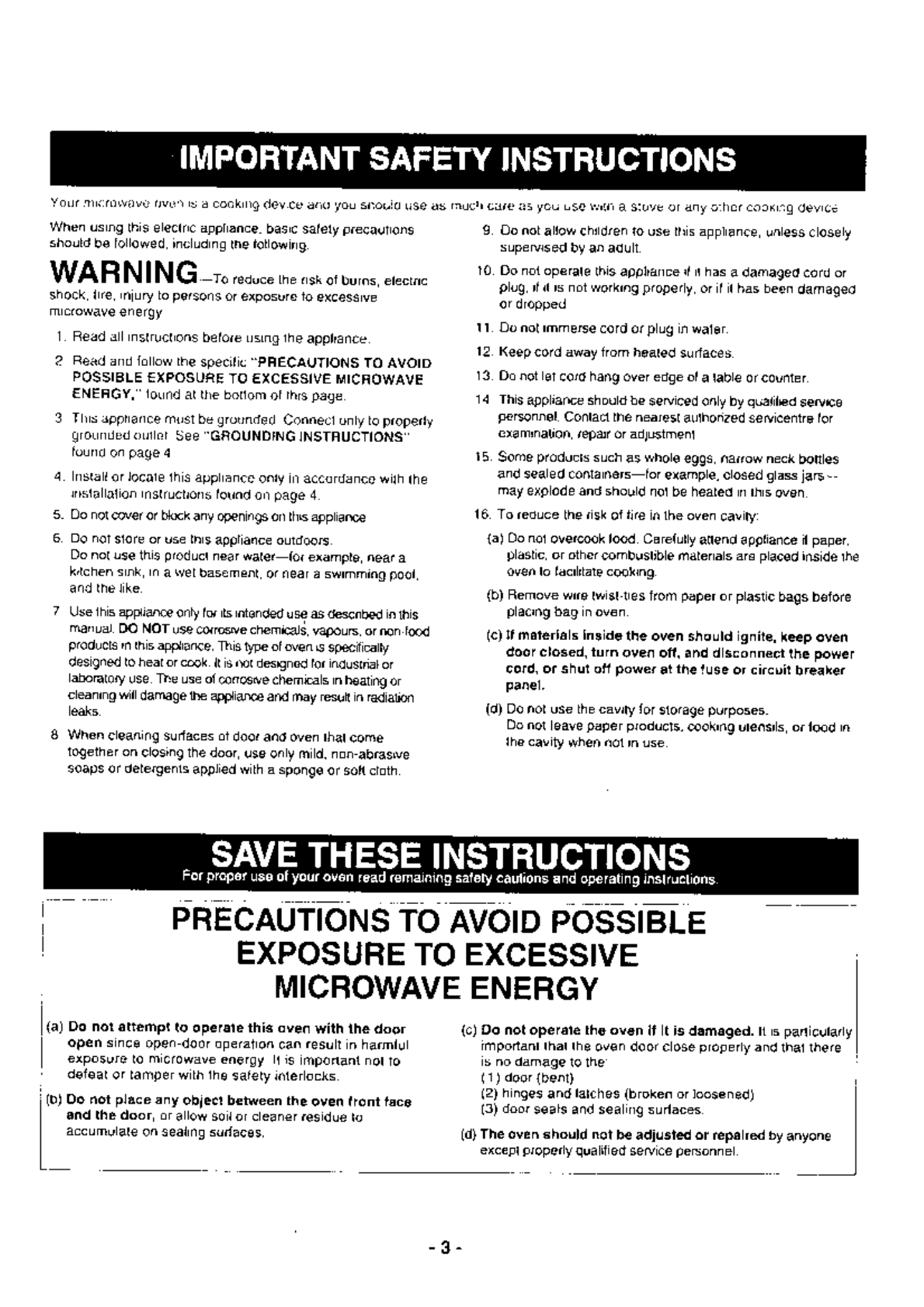
Your
mtcrowave
oven is
a cooking
devtce
and
you
should
Lrse
as much care
as
you
use
with a
stove or any
other cooking
device
When
using
this electric
appliance,
basic
safety
precautions
should
be followed,
including
the following:
WA
R N I
N
G-ro reduce
the risk
of
burns,
erecrrc
shock,
fire, injury
to
persons
or exposure
to excessive
microwave
energy:
|. Read
all
instructions
before
using
the
appliance.
2. Flead
and
follow
the
specific
"PRECAUTIONS
TO
AVOTD
POSSIBLE
EXPOSURE
TO
EXCESSIVE
MICROWAVE
ENERGY,"
found
at
the bottom
of this
page.
3. This
appliance
must be
grounded.
Connect
only to
properly
grounded
outlet.
See
"GROUNDTNG
INSTRUCTIONS"
found
on
page
4.
4. lnstall
or
locate
lhls
appliance
only in
accordance
with
the
installation
Instructions
found
on
page
4.
5. Do
not cover
or
block
any openings
on this
appliance.
6. Do
not
store
or use this
appllance
outdoors.
Do
not
use this
product
near
water-for
example,
near
a
kitchen
sink,
in
a
wet
basement,
or
near
a swimming
pool,
and the like.
7.
Use this
appliance
only for
its intended
use
as described
in
this
manual.
DO NOT
use
corrosive
chemicald,
vapours,
or non{ood
products
in
this appliance.
This type
of oven
is specifically
designed
to heat
or cook.
lt is not
designed
for industrial
or
laboratory
use. The
use
of conosive
chemicals
in
heating
or
cleaning
will damage
the
appliance
and may
result
in radiation
leaks.
8.
When
cleaning
surfaces
of door
and oven
that
come
together
on
closing
the
door,
use
only mild,
non-abrasive
soaps
or detergents
applied
with
a sponge
or soft
cloth.
9. Do not
allow children
to use this
appliance,
unless
closely
supervised
by an
adult.
.10.
Do
not
operate this
appliance if it
has
a damaged
cord
or
plug,
if it is
not working
properly,
or if it
has been
damaged
or dropped.
11.
Do not immerse
cord or
plug
in water.
12.
Keep
cord
away from
heated surfaces.
1 3. Do not
let cord
hang over
edge
of a table
or counter.
14.
This
appliance
should be
serviced only
by
qualilied
service
personnel.
Contact
the nearest
authorized
servicentre
for
examrnation,
repair
or adjustment.
15. Some
products
such
as whole
eggs, narrow
neck
bottles
and sealed
containers-for
example,
closed
glass
jars-
may
explode
and
should not
be heated
in this
oven.
16. To
reduce
the risk
of fire in
the oven
cavity:
(a)
Do not
overcook
food.
Carefully
attend appliance
if
paper,
plastic,
or other
combustible
materials
are
placed
inside
the
oven
to
facilitate
cooking.
(b)
Remove
wire
twist-ties
from
paper
or
plastic
bags belore
placing
bag
in
oven.
(c)
lf materials
inside
the oven
should
ignite,
keep
oven
door
closed, turn
oven
off, and
disconnect
the
power
cord,
or shut
off
power
at the fuse
or circuit
breaker
panel.
(d)
Do
not use
the cavity lor
storage
purposes.
Do not leave
paper products,
cooking
utensils,
or
food in
the cavity
when
not in
use.
(a)
Do not
attempt
to
operate
this
oven with
the
door
open
since
open-door
operation
can
result
in harmful
exposure
to mtcrowave
energy. lt is
important
not to
defeat
or
tamper
with
the safety
interlocks.
(b)
Do not
place
any
object
between the
oven front
face
and the
door,
or allow
soil or
cleaner
residue
ro
accumulate
on
sealino
surfaces.
(c)
Do not
operate
the oven if it
is damaged. lt
is
particularly
important
that the
oven door
close
properly
and that there
is
no damage
to the:
(1)
door
(bent)
(2)
hinges
and latches (broken
or loosened)
(3)
door seals and
sealing surfaces.
(d)
The
oven should
not be
adjusted or repaired
by
anyone
except
properly
qualified
service
personnel.
PRECAUTIONS
TO
AVOID
POSSIBLE
EXPOSURE
TO EXCESSIVE
MICROWAVE
ENERGY
-3-


















